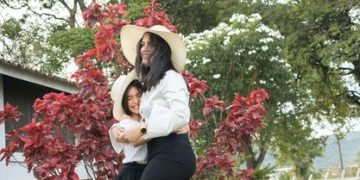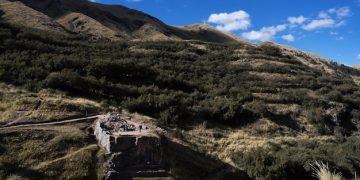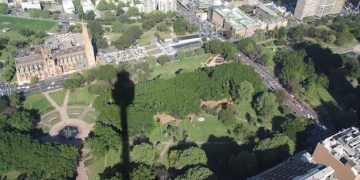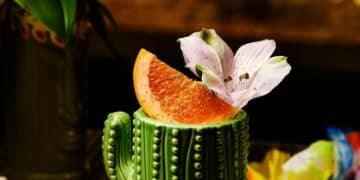Decoding Peruvian Textiles: A Souvenir Guide for US Travelers
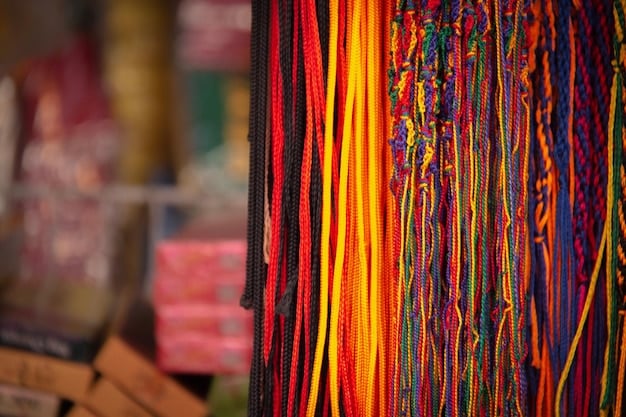
Decoding Peruvian textiles offers US travelers a unique lens into Peru’s rich cultural heritage, providing insights on how to identify authentic souvenirs and appreciate the artistry woven into each piece.
Planning a trip to Peru and hoping to bring back an authentic piece of its culture? Understanding Peruvian textiles is key. This guide will help US travelers decode the vibrant world of Peruvian weaving and find genuine souvenirs.
Understanding the Allure of Peruvian Textiles
Peruvian textiles are more than just pieces of cloth; they are living stories woven with history, tradition, and symbolism. For US travelers seeking authentic souvenirs, understanding their allure is the first step towards appreciating and acquiring meaningful keepsakes.
The art of weaving in Peru dates back thousands of years, predating the Inca Empire. These ancient techniques, passed down through generations, have resulted in a rich tapestry of styles, materials, and designs, each telling a unique story about the weaver’s community and heritage.
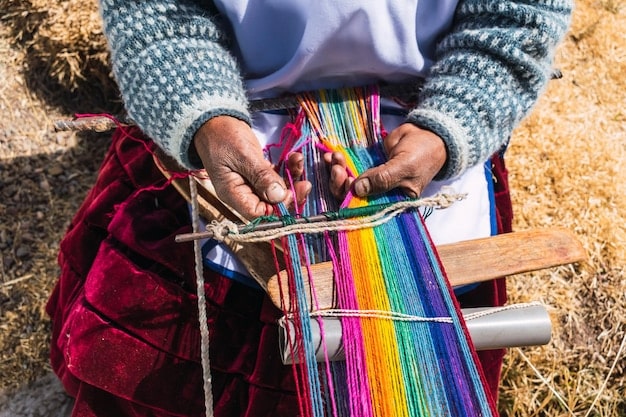
Historical Significance
Textiles played a crucial role in ancient Peruvian societies. They were used not only for clothing but also as a form of currency, a way to record history, and a symbol of status. Certain patterns and designs were reserved for royalty, indicating their power and prestige.
Symbolism in Designs
Each symbol and motif woven into a Peruvian textile carries a specific meaning. Animals like the condor, puma, and serpent are often depicted, representing the upper, middle, and lower worlds in Andean cosmology. Geometric patterns, such as diamonds and zigzags, can symbolize mountains, rivers, or agricultural cycles.
Why Authentic Textiles Matter
Purchasing authentic Peruvian textiles supports local artisans and preserves traditional crafts. Unlike mass-produced imitations, genuine textiles are made using time-honored techniques and natural materials, ensuring their quality and cultural significance.
- Supports Local Communities: Buying authentic textiles directly benefits the artisans and their families.
- Preserves Cultural Heritage: Keeps traditional weaving techniques alive for future generations.
- Unique and High-Quality: Authentic textiles are made with care and attention to detail, using quality materials.
- Meaningful Souvenir: A genuine Peruvian textile tells a story and connects you to the culture.
In conclusion, the allure of Peruvian textiles lies in their rich history, symbolic designs, and the positive impact of supporting local artisans. For US travelers, understanding these elements will enhance their appreciation and guide them toward acquiring truly authentic souvenirs.
Identifying Authentic Peruvian Textiles
Navigating the bustling markets of Peru in search of authentic textiles can be overwhelming. With a keen eye and some insider knowledge, US travelers can distinguish genuine handicrafts from mass-produced imitations.
Authenticity lies in the details. From the materials used to the weaving techniques employed, each element tells a story about the textile’s origin and craftsmanship. Learning to recognize these indicators is key to finding a truly valuable souvenir.
Materials Used
Authentic Peruvian textiles are typically made from natural fibers such as alpaca, llama, sheep’s wool, and cotton. Alpaca is particularly prized for its softness, warmth, and durability. Natural dyes, derived from plants, insects, and minerals, give the textiles their vibrant colors.
Weaving Techniques
Traditional weaving techniques, such as the backstrap loom and the treadle loom, are still widely used in Peru. The backstrap loom, a simple yet versatile tool, allows weavers to create intricate designs with great precision. Hand-woven textiles will often have slight irregularities, a testament to their unique, handcrafted nature.
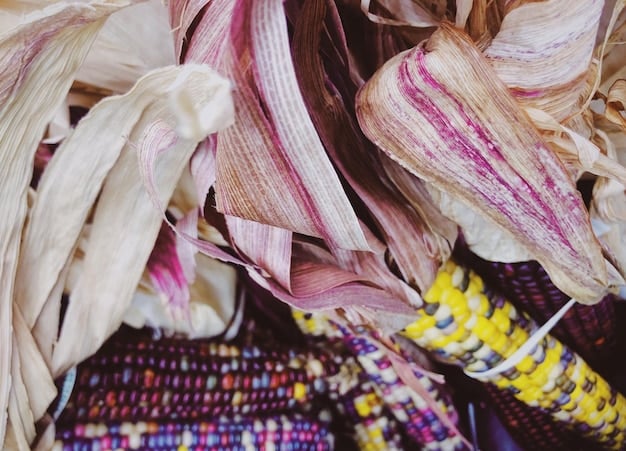
Key Indicators of Authenticity
Here are some key indicators to help you identify authentic Peruvian textiles:
- Material: Look for natural fibers like alpaca, llama, sheep’s wool, or cotton.
- Dyes: Check for natural dyes, which tend to have a softer, more nuanced color palette.
- Weaving: Examine the weave for slight irregularities and intricate designs.
- Edges: Authentic textiles often have hand-finished edges, rather than machine-stitched hems.
- Origin: Ask the vendor about the textile’s origin and the community it came from.
By paying attention to these details, US travelers can confidently navigate the markets and find authentic Peruvian textiles that truly represent the country’s rich cultural heritage. Remember to ask questions, observe closely, and trust your instincts.
Popular Types of Peruvian Textiles
Peruvian textiles showcase a diverse range of styles, each reflecting the unique cultural identity of its region. From the intricate tapestries of Ayacucho to the vibrant belts of Cusco, exploring these different types offers US travelers a deeper appreciation of Peruvian craftsmanship.
Understanding the distinctions between these textiles not only enhances your shopping experience but also allows you to select souvenirs that resonate with your personal interests and aesthetic preferences.
Ayacucho Tapestries
Ayacucho is renowned for its intricate tapestries, often depicting scenes from daily life, historical events, and mythological stories. These tapestries are woven using a technique called “tejido plano” (plain weave) and are characterized by their vibrant colors and detailed imagery.
Cusco Belts
The belts of Cusco, known as “chumpi,” are an essential part of traditional Andean dress. They are woven using a technique called “warp-faced weaving,” which creates a dense, durable fabric with intricate geometric patterns. Each pattern carries a specific meaning, often related to the wearer’s community and status.
Taquile Island Textiles
The textiles of Taquile Island, located on Lake Titicaca, are particularly unique. Here, knitting is primarily done by men, while weaving is done by women. The island’s textiles are known for their vibrant colors, intricate designs, and the social significance attached to each piece.
Mantras
Mantras are beautifully woven or embroidered cloths that serve a practical purpose in carrying babies, food or other items. The most gorgeous mantras are usually found in the Cusco region.
- Regional Differences: Each region of Peru has its own distinct style of weaving and design.
- Symbolic Meanings: Patterns and colors often carry specific meanings related to the weaver’s community and heritage.
- Diverse Techniques: From plain weave to warp-faced weaving, different techniques create unique textures and designs.
- Cultural Significance: Textiles play an integral role in traditional Andean dress and ceremonies.
In conclusion, familiarizing yourself with the different types of Peruvian textiles empowers US travelers to make informed choices and select souvenirs that truly reflect the country’s rich cultural diversity. Whether it’s a vibrant Ayacucho tapestry or an intricately woven Cusco belt, each piece tells a story waiting to be discovered.
Negotiating Prices in Peruvian Markets
Bargaining is a common practice in Peruvian markets, and knowing how to negotiate prices effectively can help US travelers get the best deals on authentic textiles. Approaching negotiations with respect and a sense of humor can lead to mutually beneficial outcomes.
Understanding the dynamics of negotiation in Peruvian markets involves recognizing cultural norms, setting realistic expectations, and maintaining a friendly demeanor throughout the process.
Understanding the Culture of Bargaining
In Peru, bargaining is not seen as confrontational but rather as a social interaction. It’s an opportunity to engage with vendors, learn about their products, and build a connection. Approaching negotiations with a friendly attitude and a smile can go a long way.
Setting Realistic Expectations
Before entering a negotiation, research the average price of similar items to set a realistic expectation. Consider the quality of the textile, the materials used, and the craftsmanship involved. Be prepared to pay a fair price that reflects the textile’s value.
Tips for Negotiating Effectively
Here are some practical tips to help you negotiate prices effectively in Peruvian markets:
- Start Low: Begin by offering a price that is lower than what you’re willing to pay, but not insultingly low.
- Be Respectful: Maintain a friendly and respectful attitude throughout the negotiation.
- Ask Questions: Show genuine interest in the textile and the artisan who created it.
- Be Willing to Walk Away: If the vendor is unwilling to negotiate to a reasonable price, be prepared to walk away. Sometimes, they will call you back with a better offer.
Negotiating prices in Peruvian markets is a skill. By understanding the culture of bargaining, setting realistic expectations, and employing effective strategies, US travelers can secure fair deals on authentic textiles while also enriching their cultural experience.
Caring for Your Peruvian Textiles
Proper care is essential to preserve the beauty and longevity of your authentic Peruvian textiles. US travelers should understand the best practices for cleaning, storing, and protecting these delicate pieces from damage.
By following these guidelines, you can ensure that your textiles remain vibrant and cherished for years to come, becoming treasured reminders of your Peruvian adventure.
Cleaning Guidelines
Most Peruvian textiles should be hand-washed with cold water and a mild detergent. Avoid harsh chemicals and bleach, as they can damage the natural fibers and dyes. Gently agitate the textile in the water, rinse thoroughly, and press out excess moisture with a towel.
Storage Tips
To prevent damage from sunlight, moisture, and pests, store your Peruvian textiles in a cool, dry place away from direct sunlight. Wrap them in acid-free tissue paper or cotton fabric to protect them from dust and insects. Avoid storing them in plastic bags, as this can trap moisture and lead to mold growth.
Protecting from Damage
To protect your Peruvian textiles from damage, consider the following tips:
- Avoid Direct Sunlight: Prolonged exposure to sunlight can fade the colors of natural dyes.
- Protect from Pests: Use cedar chips or lavender sachets to repel moths and other insects.
- Rotate Display: If you display your textiles, rotate them periodically to prevent uneven fading.
- Handle with Care: Avoid pulling or stretching the fibers, and be gentle when handling delicate pieces.
Caring for your Peruvian textiles is an investment in their future. By following these simple guidelines, US travelers can preserve the beauty and cultural significance of their souvenirs, ensuring that they remain cherished heirlooms for generations to come.
Ethical Considerations When Buying Textiles
As conscious travelers, it’s important to consider the ethical implications of purchasing souvenirs. US travelers should prioritize fair trade practices, support sustainable production methods, and ensure that their purchases benefit local communities.
By making informed and ethical choices, you can contribute to the preservation of traditional crafts and promote the well-being of the artisans who create them.
Fair Trade Practices
Fair trade organizations work to ensure that artisans receive fair wages, safe working conditions, and access to markets. Look for textiles that are certified by fair trade organizations, or purchase directly from artisan cooperatives.
Sustainable Production Methods
Support textiles that are made using sustainable production methods, such as natural dyes, organic fibers, and traditional techniques. These methods minimize environmental impact and promote the long-term health of the communities that rely on them.
Supporting Local Communities
Whenever possible, purchase textiles directly from local artisans or small-scale vendors. This ensures that your money goes directly to the people who created the product, rather than to intermediaries or foreign corporations.
- Research Certifications: Look for fair trade and sustainability certifications to guide your purchasing decisions.
- Ask Questions: Inquire about the origin of the textile, the materials used, and the working conditions of the artisans.
- Support Cooperatives: Purchase from artisan cooperatives that prioritize fair wages and community development.
- Avoid Exploitation: Be wary of unreasonably low prices, which may indicate that the artisans are being exploited.
Ethical considerations are an integral part of responsible travel. By prioritizing fair trade practices, supporting sustainable production methods, and ensuring that your purchases benefit local communities, US travelers can make a positive impact on the lives of the artisans who create these beautiful textiles.
| Key Point | Brief Description |
|---|---|
| 🧶 Authentic Materials | Look for alpaca, llama, sheep’s wool, or cotton. |
| 🎨 Natural Dyes | Check that the dyes have softer, nuanced colors derived from natural sources. |
| 🤝 Fair Trade | Support artisans directly or look for fair trade certifications. |
| 🧺 Proper Care | Hand wash with cold water, store in a cool, dry place. |
Frequently Asked Questions
▼
Authentic Peruvian textiles are predominantly crafted from natural fibers like alpaca, llama wool, sheep’s wool, and cotton. Alpaca is particularly esteemed for its softness, warmth, and durability, making it a popular choice for high-quality items.
▼
Natural dyes tend to exhibit softer, more nuanced hues compared to the often brighter and more uniform colors of synthetic dyes. Natural dyes are derived from plants, insects, and minerals, offering a unique palette reflective of the local environment.
▼
Yes, different regions in Peru boast unique textile styles. Ayacucho is famous for its detailed tapestries depicting daily life, while Cusco is known for its intricately woven belts called “chumpi,” each carrying specific cultural and symbolic meanings.
▼
Hand washing with cold water and a mild detergent is recommended. Avoid harsh chemicals and bleach. Store the textiles in a cool, dry place away from direct sunlight, ideally wrapped in acid-free tissue paper to prevent damage from pests and moisture.
▼
Purchasing fair trade textiles ensures that artisans receive fair wages and work in safe conditions. It supports sustainable production methods and helps preserve traditional crafts, contributing directly to the well-being of local communities.
Conclusion
Decoding Peruvian textiles as a US traveler not only enriches your souvenir collection but also connects you to a vibrant cultural heritage. By understanding the materials, techniques, and ethical considerations involved, you can confidently choose authentic pieces that support local artisans and honor Peru’s rich weaving traditions.
